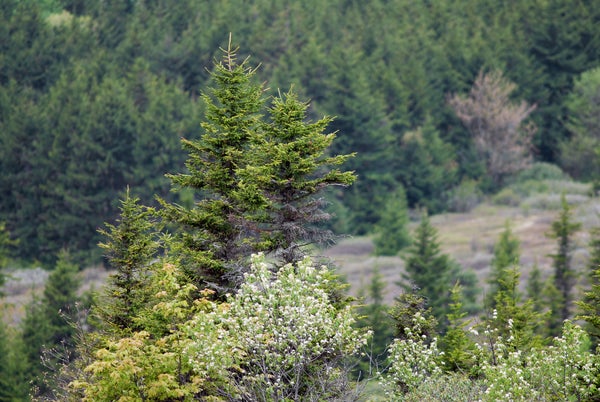Despite climate change cranking up the heat across the U.S., several eastern states have stayed curiously cool. It’s a mystery that hasn’t been fully solved—but now researchers think reforestation is partly responsible.
Many of the lush forests that are currently growing in the eastern U.S. didn’t exist two centuries ago. In the late 18th century European settlers started clearing vast swaths of the region’s trees for farmland and timber. By the early 20th century, in some forests that had existed for thousands of years, only 10 percent of trees remained. Land clearing eventually slowed by the early 1900s, partly because most of the forests had been cleared. Croplands were abandoned as people moved into growing cities or migrated west, giving trees a chance to regrow. That regeneration, along with purposeful replanting, allowed millions of acres of forests to make a comeback during the 20th century.
At the same time, the burning of fossil fuels began driving up temperatures around the U.S.—except in large parts of the southeastern and central regions. There are several theories as to why this area of cooler average temperatures, called a “warming hole,” exists: agricultural irrigation, for example, can tamp down temperatures through evaporative cooling, and aerosols (tiny particles of pollution) reflect the sun’s rays. But Indiana University ecologist Kim Novick wanted to know whether reforestation might have played a role, so she looked at where it and the U.S. warming hole overlapped—a roughly triangular area running from Louisiana to Florida and north to Pennsylvania. Novick and her colleagues recently described how the warming hole and reforestation might be connected in a study published in Earth’s Future.
On supporting science journalism
If you're enjoying this article, consider supporting our award-winning journalism by subscribing. By purchasing a subscription you are helping to ensure the future of impactful stories about the discoveries and ideas shaping our world today.
“This paper is really about the adaptation potential of reforestation,” Novick says. Many studies have examined how trees can mitigate climate change by storing carbon, but she says the new research underscores how forests can also provide a cooling presence.
Using satellite, historical temperature and weather station data, Novick and her colleagues compared how surface and air temperatures varied between forested areas and nonforested ones such as grasslands or crop fields. Air temperature was an important factor to consider, Novick says, because it helped establish that there actually was a cooling benefit. That’s because air moves, meaning cooler air can waft out of the forest ecosystem and into surrounding areas.
Next, the researchers examined how temperatures fluctuated as forests regenerated between 1900 and 2010.
They found that by the end of the 20th century, air temperatures on the hottest days were up to 1.8 degrees Fahrenheit (one degree Celsius) cooler in reforested areas than in nearby areas without forests. The surface temperature of the tree canopy was even milder: it was reduced by 1.8 to 3.6 degrees F (one to two degrees C) annually compared with surrounding nonforested land. The cooling effect was most pronounced at midday in the summer—when humans need it most—lowering surface temperatures by up to nine degrees F (five degrees C).
Forests lower temperatures through a mechanism that’s similar to sweating in humans. When trees release water vapor from their leaves in a process called transpiration, the evaporating water cools the surrounding air. The forest also helps move heat from the surface to the air more efficiently. The study authors say reforestation isn’t entirely responsible for the warming hole but could partially explain it.

A 1932 historical photograph of a 15-person planting crew in Tucker County, W.V.
Credit: Library of Congress, Prints & Photographs Division, HABS WVA,47-PARS.V,1--33
Because trees were already known to have a localized cooling effect, the new research “has results that you would expect, but it’s a very impressive analysis,” says Malcolm North, a forest ecologist at the U.S. Forest Service’s Pacific Southwest Research Station in Davis, Calif., who wasn’t involved in the new study. The study authors “make a pretty compelling case that the reforestation has had a significant influence on cooling.”
The results don’t mean trees should be planted just anywhere, however. In the desert, where there are naturally very few trees, or in boreal forests that have snow for much of the year, adding extra trees can encourage more warming. Being darker than snow, tree cover reduces a snowy area’s albedo—the measure of the sunlight it reflects back into space. In more temperate forests such as those of the eastern U.S., though, the cooling benefits of transpiration and efficient heat transfer outweigh albedo reductions.
In addition, benefits would likely only come with true reforestation, which means encouraging trees to regrow in a historically forested area. Afforestation—planting forests where none grew before—could potentially harm the environment. For example, afforestation in drier climates can reduce the available water supply.
“This doesn’t work everywhere,” says Susan Cook-Patton, senior forest restoration scientist at the Nature Conservancy. “But in more moist temperate and tropical locations, it is a promising option.” Another situation in which it would be appropriate to use reforestation for climate adaptation would be when burned areas haven’t regenerated naturally, says restoration ecologist Karen Holl of the University of California, Santa Cruz. A prime spot for this approach would be in western states such as Colorado, where massive wildfires have leveled thousands of acres of forests. Neither Cook-Patton nor Holl were involved in the new study.
Despite the eastern forests’ impressive cooling powers, the study authors and other experts caution that reforestation alone isn’t going to solve the climate crisis; only drastically reducing fossil fuel burning can do that. But encouraging forests to regrow could help some humans and ecosystems stay cooler during that transition. “We have to reduce greenhouse gas emissions,” Holl says. “We're not going to plant our way or regrow the forest out of climate change.”
